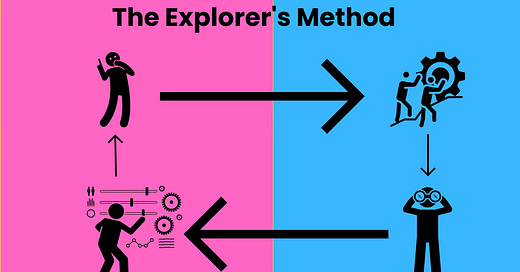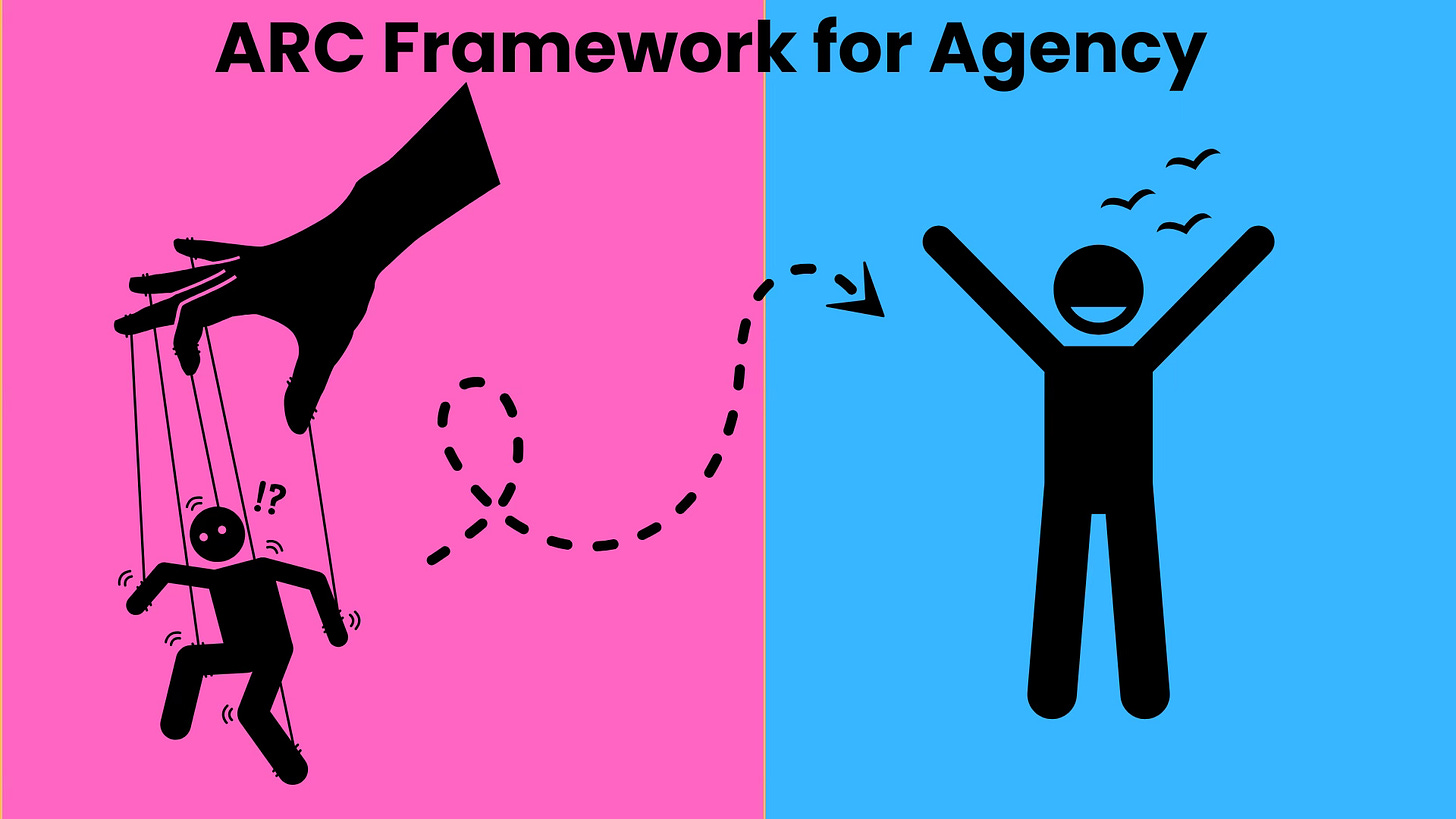You scroll through content other people created.
Go to work solving problems you didn’t choose.
Come home to binge content you don’t care about.
Sleep. Repeat.
You’re stuck in a story that isn’t yours.
You’re acting out a role that was handed to you, not chosen by you.
But what if you could rewrite the script?
What You'll Learn:
In this newsletter, you'll learn:
Why you feel like a background character in your own life
How societal systems train you to stay passive
The ARC Framework for building agency and direction
Neuroscience-backed tactics to reprogram how you think
A goal-setting method that actually works in the real world
A 4-step execution system to transform action into momentum
Let’s begin with the root cause:
Not laziness. Not fear.
Learned helplessness.
The ARC Framework for Agency
Awareness → See the hidden scripts controlling your life
Reprogramming → Upgrade your thinking with systems thinking and neuroscience
Creation → Build the capability to act, iterate, and direct your own life
Each stage deepens your clarity and compounds your momentum. Let’s break it down.
If you want to leverage AI for this framework, consider my 48 AI Blueprint, which has detailed AI prompts with its use case- [Access here]
1. Awareness: Escape the Invisible Prison
In 1967, psychologist Martin Seligman ran a disturbing experiment.
Dogs exposed to repeated, uncontrollable shocks eventually stopped trying to escape, even when freedom was just a jump away.
This is learned helplessness.
And this is your life if you’re not careful.
You’ve been conditioned by:
Parents who inherited scripts they never questioned
Schools that reward memorization over exploration
Jobs that demand compliance over creativity
You’ve been taught to accept limitations that don’t exist.
But here’s the truth:
If helplessness can be learned, so can agency.
The first key to awareness is noticing the spotlight you’ve been living under — and expanding it.
Which leads us to the next piece of the framework: reprogramming.
2. Reprogramming: Shift From Follower to Leader
Your attention literally constructs your reality.
Most people live with Spotlight Consciousness:
They only see what authority figures point to —
what parents approve, teachers assign, algorithms promote.
High-agency people cultivate Floodlight Consciousness —
a broader, flexible awareness of opportunities that others ignore.
The key player?
Your Reticular Activating System (RAS) — the brain’s filter.
When you rewire your RAS, you don’t change the world.
You change what you notice about it.
Example: Buy a new car, and suddenly you see that model everywhere. The cars were always there — your brain just started caring.
With floodlight awareness, you start spotting your own scripts — and other people's. This is where you start breaking out of tribal mindsets.
Let’s go deeper.
3. Reprogram the Mental Models: Escape the Three Camps
Most people get stuck in one of three psychological camps:
Order Worshippers – need rules and structure to feel safe
Achievement Addicts – rely on metrics to feel valuable
Egalitarians – believe all perspectives are equal, except their own
Each camp limits your reality.
The solution?
Stop choosing sides.
Start transcending perspectives.
This is what Clare Graves' psychological development theory uncovered — we evolve in predictable tiers of thinking.
But most people defend their tier rather than evolve from it.
High-agency people absorb the best of all perspectives — without being trapped by any.
This unlocks true transformation. Which brings us to…
4. Creation: Build Your Own Map Through Action
Agency = Action without permission.
But most people wait.
Wait for the perfect idea.
The perfect moment.
The perfect confidence.
That moment never comes.
So here’s the reframe:
You don’t need clarity to move.
You move to gain clarity.
This is how explorers operate.
They don’t wait for full visibility — they take one step into the fog, and let that new vantage point reveal the next step.
Here’s how to do that practically.
The Explorer's Method: Evolve Through Experiments
Instead of setting rigid goals, use this loop:
Guess — Make an educated hypothesis
Act — Run a small, fast experiment
Observe — Study the feedback
Adjust — Use results to evolve
This loop creates momentum and builds the one thing most people lack:
Psychological leverage.
You stop being paralyzed by options and start building proof.
But to do that well, you need the right goal-setting psychology.
I use AI prompts which are interlined with each other to take this to next level - [Access here]
Real Goal-Setting: Stretch Without Snapping
Most advice on goals is trash because it ignores human psychology.
According to Mihaly Csikszentmihalyi, flow happens when goals are just hard enough to stretch you — but not so hard you snap.
Let’s simplify:
Easy Goals → Boredom
Impossible Goals → Paralysis
Difficult-but-Possible Goals → Flow, growth, momentum
Example:
“Make $100K in 18 months” → Hard, but doable with learning and focus
“Become a billionaire in 30 days” → Delusion
The magic is in the stretch.
And once you hit one difficult goal, your brain rewires.
What was impossible becomes your new baseline.
So… how do we actually hit those goals?
The 4-Step Execution System
Goal – Choose something meaningful that makes you slightly uncomfortable
Experiment – Take fast, imperfect action to test your assumptions
Experience – Study the result like a scientist
Confirmation – Decide: double down or change direction?
Repeat this loop weekly, and your life will look unrecognizable in 6 months.
Why?
Because you’re not just achieving things —
You’re becoming someone who achieves things.
Your Next Action
You have two choices:
Keep following a script written by people who don’t know you, and don’t care.
Or start directing your own story.
Here’s how to begin:
✅ Identify one place in your life where you’re waiting for permission
✅ Find one resource you already have
✅ Run a tiny experiment this week — before you feel “ready”
Grab a copy of my AI Writing Blueprint- [Access here]
Grab a copy of my 48 Prompt Framework Library- [Access here]






